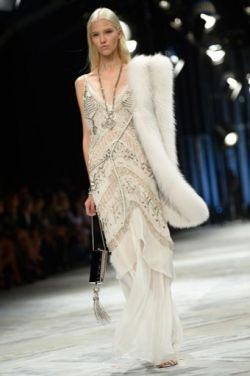Milan fashion stars pay homage to film classics

“Welcome to my movie set!” the silver-maned Cavalli, dressed in a black suit and sunglasses, told journalists at the start of the catwalk show, sweeping his arm across a vast marquee tent with spotlights and celluloid decorations.
Models dressed like glamorous 1930s film stars paraded in an array of shimmering figure-hugging gowns with furs thrown over the shoulder.
Whites, blacks and silvers dominated the spring/summer 2014 collection, which conveyed a sense of high elegance, plus Cavalli’s signature sensuality with see-through and backless lace dresses that left little to the imagination.
Cavalli, whose German Shepherd “Lupo” (“Wolf”) kept inquisitive reporters in check, said he wanted an “eccentric, romantic and exuberant” look.
There were also jackets and trousers made from a patchwork of python, iguana and crocodile skins along with denim — a return to wildlife themes for Cavalli, who has become perhaps best known for his leopard-print clothes.
Cavalli said he had looked to the film world because fashion and cinema shared the same inspiration — “an artistic vision that uses the best artisanal techniques to give life to a place where dreams become possible”.
French-owned Italian fashion house Fendi also paid homage to the symbiotic relationship between these two worlds in an exhibition unveiled this week entitled “Making Dreams” at the Teatro Manzoni — a classic 1940s cinema.
“Our catwalks are like canvases through which we tell stories,” Silvia Venturini Fendi said at the exhibition, which highlights Fendi’s relationship with directors from Martin Scorsese to Wim Wenders to Luchino Visconti.
A variety of Fendi fur coats could be seen on mannequins in the cinema’s red velvet seats and included the ones worn by Michelle Pfeiffer in “The Age of Innocence” (1993) or Gwyneth Paltrow in “The Royal Tenenbaums” (2003).
There were also sketches by famous costume designer Piero Tosi for Fendi outfits to be worn by the voluptuous diva Silvana Mangano, who starred in Pier Paolo Pasolini’s “Theorem” (1968) and Visconti’s “Death in Venice” (1971).
“Fashion will never stop clothing cinema,” Milan’s Cineteca film archive said in a statement for the inauguration of a fashion-themed season.
“Since it dawned, cinema has always been intricately connected to fashion. Divos and divas helped create styles and trends and the celluloid catwalks handed fame to the main brands, turning them into true icons,” it said.
The series includes the vintage “Vogues of 1938” about the fashion models of the era and continues into modern day with “Valentino: The Last Emperor” (2008) and “The September Issue: Anna Wintour and the Making of Vogue” (2009).

